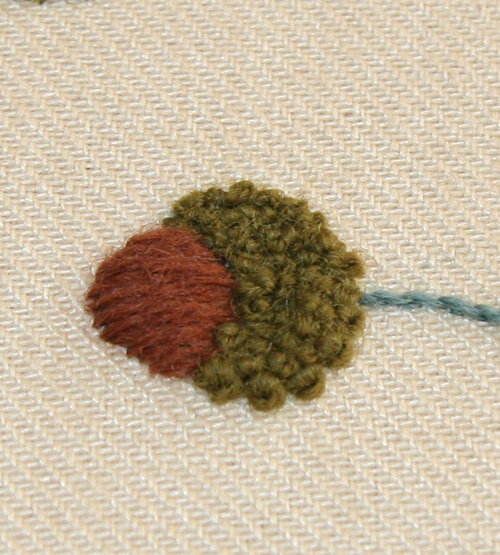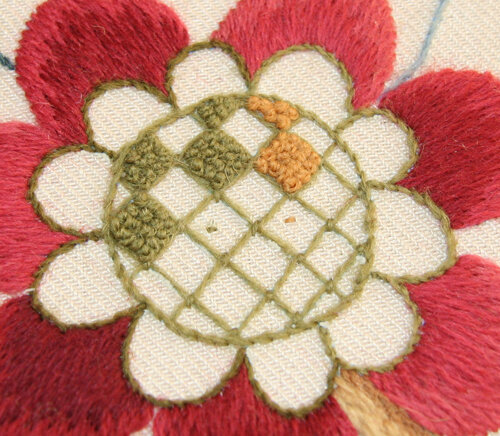French knots as filling
I love French knots. I love doing them and I love touching them and I love how they can look so different depending on how they're placed in a shape. In the Marriage Pillowe I'm stitching, Phillipa Turnbull has used French knots to fill three shapes in different ways.The first is this little acorn. Often the tops of acorns are done with French knots. Here the knots fill in the shape randomly and they're perfect for mimicking the texture of the cap of an acorn. At the bottom of the stems of the large flowers on both sides of the Marriage Pillowe, the French knots follow carefully the curve of the hillock. The different colors are worked in rows, some longer than others, to create what looks a lot like the ground. I especially like that the bottom edge of the hillock isn't a straight line nor does the bottom color go all the way across the bottom of the shape. It looks just perfect this way!
At the bottom of the stems of the large flowers on both sides of the Marriage Pillowe, the French knots follow carefully the curve of the hillock. The different colors are worked in rows, some longer than others, to create what looks a lot like the ground. I especially like that the bottom edge of the hillock isn't a straight line nor does the bottom color go all the way across the bottom of the shape. It looks just perfect this way! In the large flower on the right side of the piece, French knots are used to fill in the squares of the laid and couched trellis work. Here Phillipa has created a 4 x 4 grid of knots. It looks a little like tiny carpet samples. It's quite a different texture from the randomness of the acorn or the curves of the hillock.
In the large flower on the right side of the piece, French knots are used to fill in the squares of the laid and couched trellis work. Here Phillipa has created a 4 x 4 grid of knots. It looks a little like tiny carpet samples. It's quite a different texture from the randomness of the acorn or the curves of the hillock. When I had finished the whole flower, I could see what a great choice these rows of French knots were! The blocks of different colored texture make an interesting and unique filling for the large flower. I just love it!When I first started to embroider again, I was unsure about the best way to make French knots. I still don't get them as uniform as I'd like but I'm getting better. Phillipa kindly taught us in her workshop in Burford what I think is the best, most foolproof way to make French knots. Below you will find a link to a video slide show with instructions I made to share with you.
When I had finished the whole flower, I could see what a great choice these rows of French knots were! The blocks of different colored texture make an interesting and unique filling for the large flower. I just love it!When I first started to embroider again, I was unsure about the best way to make French knots. I still don't get them as uniform as I'd like but I'm getting better. Phillipa kindly taught us in her workshop in Burford what I think is the best, most foolproof way to make French knots. Below you will find a link to a video slide show with instructions I made to share with you.
Click here to watch the French knot how to video slide show
What's your feeling about French knots? Love them, hate them or ambivalent? Any tricks? Let us know!
